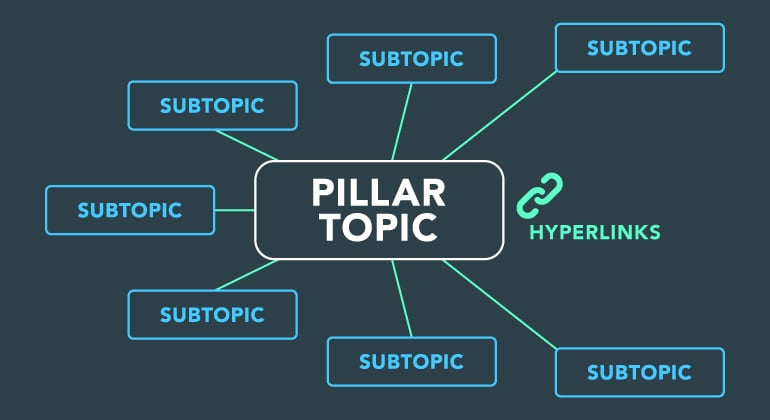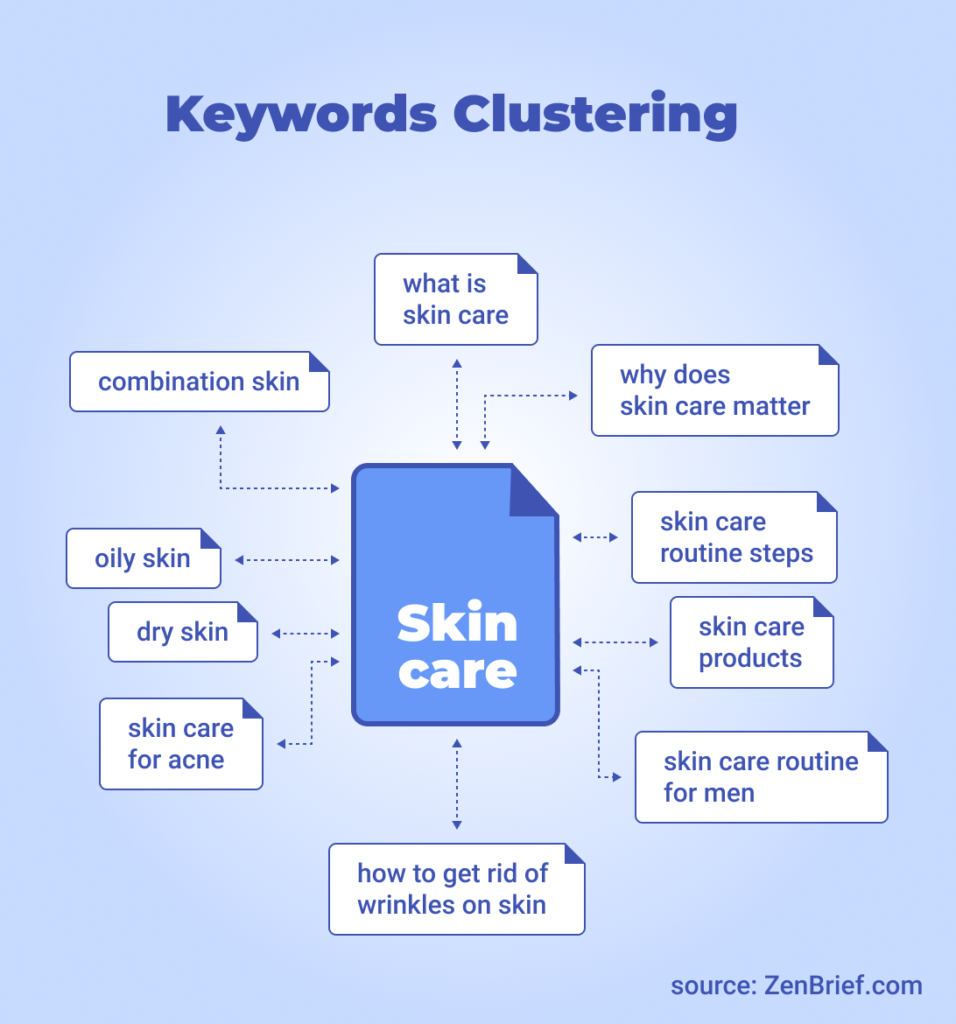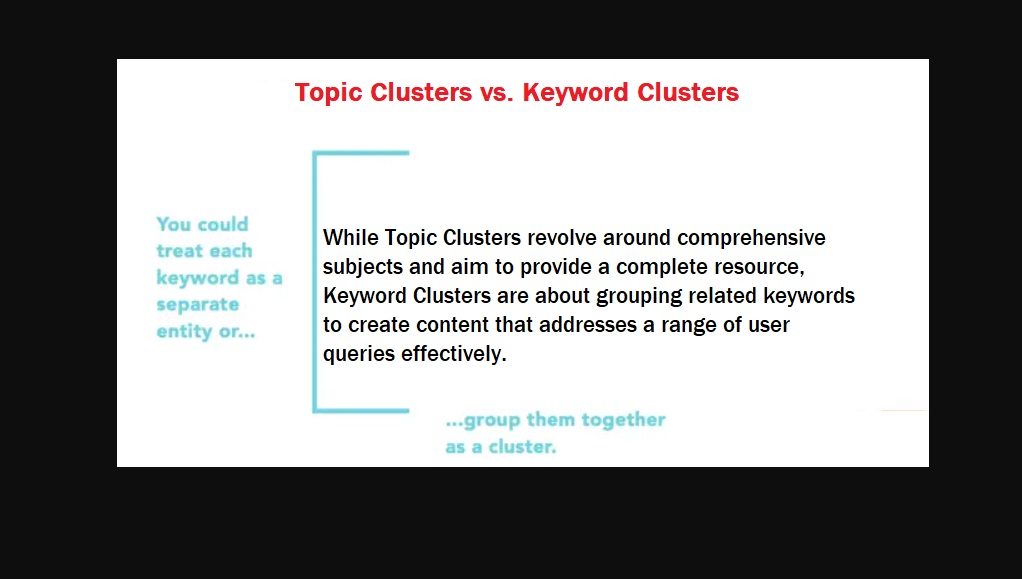As Google’s algorithms continually adapt to changing user behavior, a powerful strategy has emerged -translating keywords into a highly focused topical approach.
Reportedly, this transition is driven by a growing awareness of the enhanced ranking potential building topical authority brings.
Adopting this strategy has not only rewarded website owners with improved visibility on search results but has also reshaped the very foundation of how content is now structured.
In this article, we’ll expound on topic clusters vs keyword clusters, explaining how they can be used interchangeably to refine your SEO content strategy.
Table of Contents
What is the Difference Between Keywords and Topics Use?
If you’re unfamiliar with the concept, building topical authority is not just about peppering your content with multiple keywords anymore. Rather, It’s about becoming the go-to source for information within a specific subject area.
This brings us to the intriguing comparison of topic clusters vs. keyword clusters.
While both are valuable approaches in their own right, understanding when and how to use them can make all the difference in your SEO content strategy.
Keywords: The Foundation of SEO
Keywords are the phrases or words users type into search engines to find information. Think of them as the individual bricks that make up the structure of your content.
Traditionally, SEO efforts focused on optimizing content for specific keywords. While this approach is still relevant, it’s no longer the whole story.
Topics: The Glue That Binds Keywords Together
Topics, on the other hand, are the glue that binds these keywords together.
Imagine them as the blueprint for constructing a skyscraper. A topic encompasses a broader subject, and within it, you find a constellation of related keywords.
For instance, the topic “mobile technology” can encompass keywords like “smartphones,” “tablets,” “wearable tech,” and many more.
The Evolution of Search Intent
Understanding the shift from keywords to topics is crucial.
Google’s algorithms have become increasingly sophisticated, prioritizing not just keyword matching but also the context and relevance of the content.
Users now expect a more holistic response to their queries, and Google aims to deliver just that.
What is a Topic Cluster?
Now that we’ve grasped the difference between keywords and topics, it’s time to embark on a journey into the heart of modern SEO strategy: the Topic Cluster. We will start by outlining its three main key components…
1. The Pillar of Content
Envision your website as a library, and at its core sits the “pillar content” or the cornerstone of your Topic Cluster strategy.
This isn’t just any article; it’s a meticulously crafted, all-encompassing guide that serves as the definitive resource for your chosen topic.

It’s the beacon that guides visitors through your content library, providing an overview of the subject and, crucially, pointing the way to more detailed information contained in the subtopics.
2. Subtopics: Supporting Cluster Pages
Around this pillar content, we create a constellation of subtopics, each serving as an individual chapter or section within our library.
These subtopics are distinct articles, each focusing on a related aspect of the core subject.
As such, each subtopic article should dive deep into its specific area while still being interconnected with the rest of the content.
3. Hyperlinks (Anchor Text) and Internal Linking
Notably, each subtopic article contains anchor texts or hyperlinks that connect back to the pillar content. These links create a web of interconnected information, signaling to search engines that your content is comprehensive, well-structured, and authoritative.
Similar to the cross-references you’d find in a scholarly book—each piece of content reinforces and builds upon the others.
From an SEO perspective, when internal linking is done properly, the search engine not only finds your pillar content but also sees the web of interconnected subtopics, recognizing your website as an authority on the subject.
In the long run, this significantly boosts your chances of ranking higher in search results.
What is Meant by Keyword Clustering?
Now that we’ve grasped the power of Topic Clusters, it’s time to turn our attention to another crucial element of modern SEO: Keyword Clusters.
This is the process of grouping related keywords into clusters, which are made up of search phrases that share semantic relevance or intent. Instead of optimizing individual pages for single keywords, you’re now optimizing for a group of closely related keywords.

At a glance, the primary goal of Keyword Clustering is to enhance content organization and relevance. Ideally, by structuring your content around clusters of related keywords, you create a more comprehensive and user-focused resource.
Keyword Clustering also aligns well with Google’s emphasis on user intent. This is primarily because modern search engines aim to understand not just what keywords are in a query but also the underlying intent behind them.
From a user’s perspective, Keyword Clustering also leads to a more satisfying experience – as they often enter search queries with variations and nuances.
Fortunately, there are various automated tools that can help group keywords by their semantic relevance, including ChatGPT.
This is also a very important step when creating a topical map for SEO.
Topic Clusters Vs Keyword Clusters: The Main Differences
The primary difference between a Topic Cluster and a Keyword Cluster lies in their focus and purpose in your overall SEO Content Strategy.

The primary purpose of Topic Clusters is to provide users with a holistic and authoritative resource on a specific topic.
As we saw earlier, they typically consist of a pillar content piece supported by related subtopic articles, all interconnected through internal links.
As such, they signal to search engines that you are an authority in a particular subject and enhance the user experience by offering in-depth information while encouraging exploration within a topic.
On the other hand, Keyword Clusters are more narrowly focused on specific search query variations, grouping related phrases that share semantic relevance or user intent.
When it comes to executing your content strategy, Keyword Clusters play an important role by enhancing content optimization and relevance.
| Aspect | Topic Cluster | Keyword Cluster |
| Focus: | Broad, overarching subject or theme | Group of related keywords |
| Purpose: | Provide a comprehensive resource | Enhance content optimization and relevance |
| Use: | Organize and structure content | Address a range of user queries |
How to Assign Keyword Clusters to a Topic Cluster
By now, we’ve established the main comparison in topic clusters vs keyword clusters.
However, the real magic happens when these two elements converge within a cohesive SEO strategy.
Now, let’s break down the practical steps to ensure you’re on the right path to optimizing your content effectively.
Step 1: General Keyword Research
The foundation of any successful SEO strategy is thorough keyword research.
Start by identifying a broad range of keywords relevant to your website’s main theme.
Utilizing keyword research tools like Google Keyword Planner, SEMrush, or Ahrefs, pay attention to metrics such as search volume, competition, and keyword difficulty.
This data will help you prioritize and select the most promising keywords.
Step 2: Cluster Keywords
Once you’ve compiled a list of relevant keywords, the next step is to group them into clusters based on semantic similarity and user intent.
These clusters should consist of keywords that share common themes, intent, or context.
For example, if you’re in the fitness industry, you might create clusters like “weight loss tips,” “strength training exercises,” and “nutrition advice.”
Step 3: Identify the Main Topics
With your keyword cluster results in hand, it’s time to identify the main topics that will serve as the pillars of your Topic Cluster Content Strategy.
Visualize with a topical authority map, assigning each keyword cluster to a broader topic or theme. These topics should align with the overarching content strategy of your website.
Next, brainstorm content ideas for each main topic. Remember, these ideas should serve as the core pieces of content (pillar content) around which your clusters will revolve.
Think of these main topics as the chapters in a book, and your clusters as the subtopics within each chapter.
Step 4: Create High-Quality Content
Once you’ve mapped out your clusters and identified main topics, it’s time to create content that aligns with your strategy.
Start by developing high-quality, comprehensive pillar content for each main topic.
As we earlier mentioned, these pieces should be the authoritative sources of information on their respective subjects.
For cluster content, create individual articles or pages for each keyword cluster within a topic. These articles should dive deeper into specific aspects related to the main topic, covering the keywords within the cluster naturally and comprehensively.
Step 5: Interlink Content
The strength of your Topic Cluster strategy lies in the interconnectivity of your content pieces. Implementing internal links strategically is crucial.
Within each article or page, insert hyperlinks to other relevant articles within the same cluster or main topic.
The goal is to create a user-friendly experience where readers can seamlessly navigate between related content pieces.
Therefore, ensure that the anchor text of these links includes the target keywords.
This keeps users engaged and encourages them to explore more of your site.
Step 6: Monitor and Update
Finally, remember that SEO is an ongoing process. Regularly monitor the performance of your Topic Cluster and Keyword Cluster strategy.
Use analytics tools to track key metrics, including organic traffic, click-through rates, rankings, and user engagement.
If you notice underperforming clusters or content, consider updates and improvements. Fresh, relevant content is favored by search engines.
CONCLUSION
To sum up, we’ve covered the main distinctions in topic clusters versus keyword clusters, and how to apply them.
Ultimately, understanding that keywords are the building blocks while topics provide the overarching structure is crucial.
By creating well-structured Topic Clusters and intelligently grouping related keywords, you can enhance your content’s relevance, user experience, and search engine visibility.



